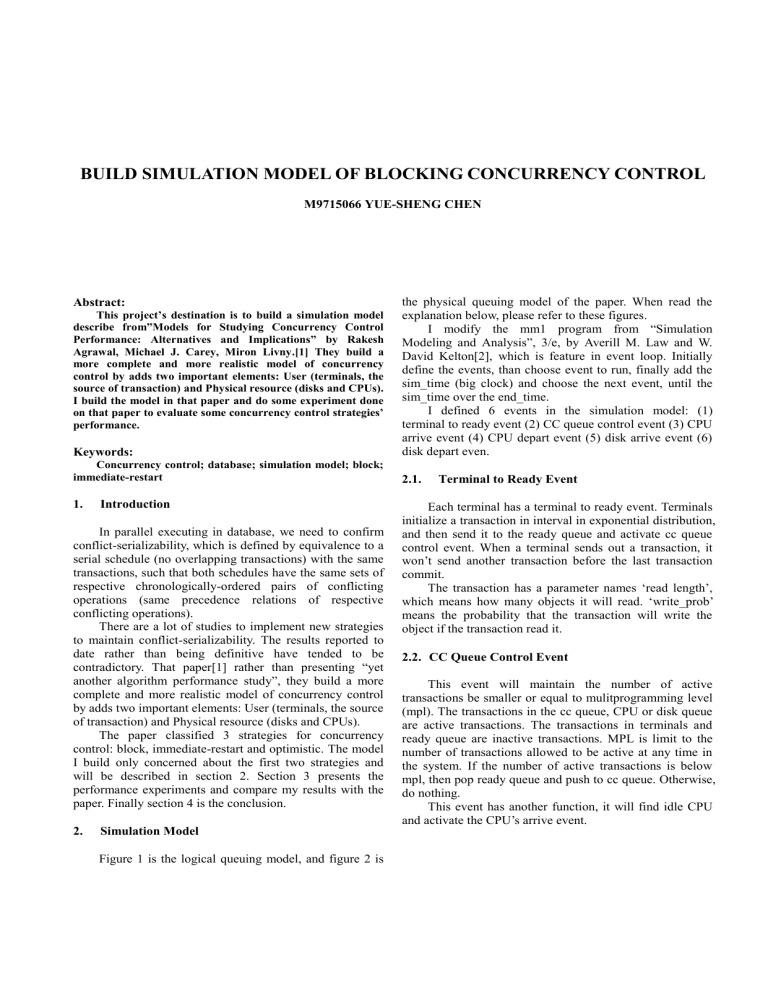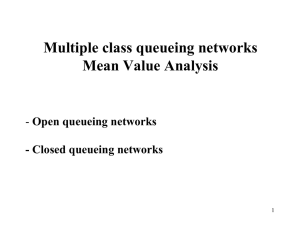Build simulation Model of Blocking Concurrency Control

BUILD SIMULATION MODEL OF BLOCKING CONCURRENCY CONTROL
M9715066 YUE-SHENG CHEN
Abstract:
This project’s destination is to build a simulation model describe from”Models for Studying Concurrency Control
Performance: Alternatives and Implications” by Rakesh
Agrawal, Michael J. Carey, Miron Livny.[1] They build a more complete and more realistic model of concurrency control by adds two important elements: User (terminals, the source of transaction) and Physical resource (disks and CPUs).
I build the model in that paper and do some experiment done on that paper to evaluate some concurrency control strategies’ performance. the physical queuing model of the paper. When read the explanation below, please refer to these figures.
I modify the mm1 program from “Simulation
Modeling and Analysis”, 3/e, by Averill M. Law and W.
David Kelton[2], which is feature in event loop. Initially define the events, than choose event to run, finally add the sim_time (big clock) and choose the next event, until the sim_time over the end_time.
I defined 6 events in the simulation model: (1) terminal to ready event (2) CC queue control event (3) CPU arrive event (4) CPU depart event (5) disk arrive event (6) disk depart even. Keywords:
Concurrency control; database; simulation model; block; immediate-restart 2.1.
Terminal to Ready Event
1.
Introduction
In parallel executing in database, we need to confirm conflict-serializability, which is defined by equivalence to a serial schedule (no overlapping transactions) with the same transactions, such that both schedules have the same sets of respective chronologically-ordered pairs of conflicting operations (same precedence relations of respective conflicting operations).
There are a lot of studies to implement new strategies to maintain conflict-serializability. The results reported to date rather than being definitive have tended to be contradictory. That paper[1] rather than presenting “yet another algorithm performance study”, they build a more complete and more realistic model of concurrency control by adds two important elements: User (terminals, the source of transaction) and Physical resource (disks and CPUs).
The paper classified 3 strategies for concurrency control: block, immediate-restart and optimistic. The model
I build only concerned about the first two strategies and will be described in section 2. Section 3 presents the performance experiments and compare my results with the paper. Finally section 4 is the conclusion.
Each terminal has a terminal to ready event. Terminals initialize a transaction in interval in exponential distribution, and then send it to the ready queue and activate cc queue control event. When a terminal sends out a transaction, it won’t send another transaction before the last transaction commit.
The transaction has a parameter names ‘read length’, which means how many objects it will read. ‘write_prob’ means the probability that the transaction will write the object if the transaction read it.
2.2. CC Queue Control Event
This event will maintain the number of active transactions be smaller or equal to mulitprogramming level
(mpl). The transactions in the cc queue, CPU or disk queue are active transactions. The transactions in terminals and ready queue are inactive transactions. MPL is limit to the number of transactions allowed to be active at any time in the system. If the number of active transactions is below mpl, then pop ready queue and push to cc queue. Otherwise, do nothing.
This event has another function, it will find idle CPU and activate the CPU’s arrive event.
2.
Simulation Model
Figure 1 is the logical queuing model, and figure 2 is
wait a restart delay. Finally restart it. Restart is send the transaction to the ready queue.
If no conflict, this event will lock the objects that the transaction wanted to access, and then activate the CPU’s depart event.
I used a integer array to show objects’ lock situation.
0: unlocked
1: write lock
2 and over: read lock (2: a transaction read, 3: 2 transactions read, and such like)
In read access, if the object is 0 (unlocked), set it to 2
(read lock). If the object is more than 2 (read lock), plus 1
(still read lock). If the object is 1 (write lock), deny the access.
In write access, if the object is 0 (unlocked), set it to 1
(write lock). Otherwise (read lock or write lock), deny the access.
2.4.
CPU Depart Event
In this simulation model we have do 2 circles of CPU
A/D for read and write. Because we assume transactions performs all of its reads before performing any writes and using deferred update, i.e., update the write in the commit time
Set the CPU idle and Random choose a disk queue and put the transaction in it. Activate the Disk Arrive event .
In the read circle, let sim_time past OBJ_CPU * READ_LEN time.
In the write circle, let sim_time past OBJ_CPU * WRITE_LEN time.
2.5.
Disk Arrive Event
If the disk is busy, wait a while , If the disk is idle, set it to busy and activate Disk Depart Event after OBJ_IO *
READ_LEN or OBJ_CPU * WRITE_LEN .
2.6. Disk Depart Event
2.3. CPU Arrive Event
In this event will set the CPU to busy and detect if the transaction will conflict with other transactions. If conflict, in block strategy, block the transaction until it won’t conflict. To detect deadlock, we set a deadlock timeout. If the block time was over the deadlock timeout, restart the transaction. In immediate-restart strategy, if the database denied the access request, then abort the transaction and
Set the disk idle. If have write, do another CPU A/D
→
DISK A/D circle for write (Don
’ t need detect conflict again, because we already lock the objects) . Then commit this transaction to terminal.
We do commit in the Disk Depart Event. It will unlock the objects and Activate Terminal to Ready Event.
In unlock phase, if the object is 2 (read lock), mean no other transactions read this object, so set it to 0 (unlocked).
If the object is over 3 (read lock), mean other transactions was reading this object, so minus 1 (still read lock). If the object is 1 (write lock), set it to 0 (unlocked).
3.
Performance Experiment
Table 1 is the environment constants of the experiments, and table 2 is the setting of environment constants of the experiments. of limited resource experiment. Throughput reached a limit near to 5, because the executive resource already be saturated.
Figure 5~7 shows the result of the normal conflict situation of infinite resource. Figure 5’s y axis is throughput, my block’s results was over the paper. Paper said more mpl, more block, the thrash will decrease the throughput, but my result have no obvious thrash. I guess the cause was the setting of deadlock timeout. The paper didn’t define how long of the deadlock timeout. Maybe it’s a dynamic variable. My immediate-restart’s result was almost same as the paper. In figure 6, whose y axis is conflict ratio, my block’s restart ratio was lower than the paper in the same cause of figure 5. In figure 7, whose y axis is response, my block’s delay was lower than the paper in the same cause of figure 5.
Figure 3 shows the result of the low conflict situation of infinite resource experiment. I used 1000 CPUs / 1000
Disks to implement “Infinity Resource”. In low conflict situation, DB_SIZE is 10000, almost no conflicts.
Throughput (committed transactions per second) reached a limit near to 125, because the providing of transactions from terminals already be saturated.
Figure 4 shows the result of the low conflict situation
Figure 8~9 shows the result of the normal conflict
situation of limited resource. Figure 8’s y axis is throughput; my result has trivial difference to the paper. In figure 9, we can see my standard variance of immediate-restart delay was smaller than the paper. I guess the cause is that I only considered the executive time of commit transactions, not count the transactions in the queue of the end. That make my result became more stable than the paper.
4.
Conclusions
In this project I learned a lot of thing. I have more knowledge of database concurrency control and simulation model. I also learn a lot from coding in C language. I’ll use the experience in the future studies and researches.
References
[1] Rakesh Agrawal, Michael J. Carey, Miron Livny:
Models for Studying Concurrency Control
Performance: Alternatives and Implications. SIGMOD
Conference 1985: 108-121
[2] Simulation Modeling and Analysis, 3/e, by Averill M.
Law and W. David Kelton
Figure 10~11 shows the result of the normal conflict situation of multiple resource. Figure 10 is 10 CPUs / 20 disks and figure 11 is 25 CPUs / 50 disks. Both of the experiments’ results were similar to the normal conflict situation of infinite resource experiment. Block’s throughput was higher than the paper and immediate-restart was similar to the paper. The cause is as same as before: deadlock timeout.






